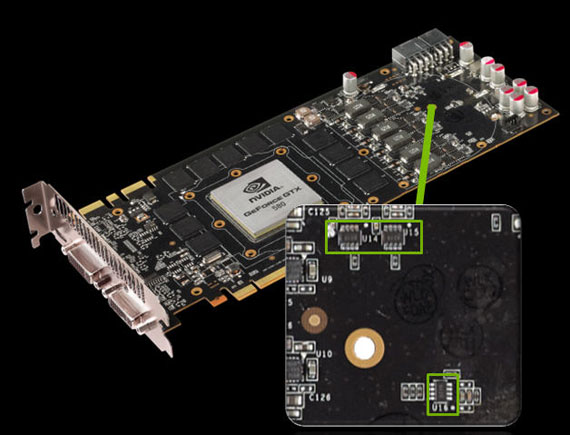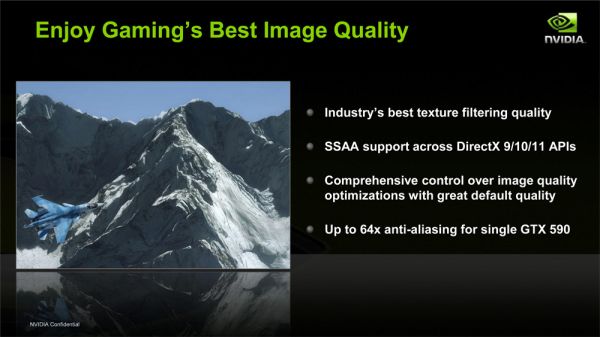NVIDIA’s GeForce GTX 590: Duking It Out For The Single Card King
by Ryan Smith on March 24, 2011 9:00 AM ESTOCP Refined, A Word On Marketing, & The Test
As you may recall from our GTX 580 launch article, NVIDIA added a rudimentary OverCurrent Protection (OCP) feature to the GTX 500 series. At the time of the GTX 580 launch, OCP would clamp down on Furmark and OCCT keep those programs from performing at full speed, as the load they generated was so high that it risked damaging the card. As a matter of principle we have been disabling OCP in all of our tests up until now as OCP was only targeting Furmark and OCCT, meaning it didn’t provide any real protection for the card in any other situations. Our advice to NVIDIA at the time was to expand it to cover the hardware at a generic level, similar to how AMD’s PowerTune operates.

We’re glad to report that NVIDIA has taken up at least some of our advice, and that OCP is taking its first step forward since then. Starting with the ForceWare 267 series drivers, NVIDIA is now using OCP at all times, meaning OCP now protects against any possible program that would generate an excessive load (as defined by NVIDIA), and not just Furmark and OCCT. At this time there’s definitely still a driver component involved as NVIDIA still throttles Furmark and OCCT right off the bat, but everything else seems to be covered by their generic detection methods.
At this point our biggest complaint is that OCP’s operation is still not transparent to the end user. If you trigger it you have no way of knowing unless you know how the game/application should already be performing. NVIDIA tells us that at some point this will be exposed through NVIDIA’s driver API, but today is not that day. Along those lines, at least in the case of Furmark and OCCT OCP still throttles to an excessive degree—whereas AMD gets this right and caps anything and everything at the PowerTune limit, we still see OCP heavily clamp these programs to the point that our GTX 590 draws 100W more under games than it does under Furmark. Clamping down on a program to bring power consumption down to safe levels is a good idea, but clamping down beyond that just hurts the user and we hope to see NVIDIA change this.
Finally, the expansion of OCP’s capabilities is going to have an impact on overclocking. As with reporting when OCP is active, NVIDIA isn’t being fully transparent here so there’s a bit of feeling around at the moment. The OCP limit for any card is roughly 25% higher than the official TDP, so in the case of the GTX 590 this would translate into a 450W limit. This limit cannot currently be changed by the end user, so overclocking—particularly overvolting—risks triggering OCP. Depending on how well its generic detection mode works, it may limit extreme overclocking on all NVIDIA cards with the OCP hardware at the moment. Even in our own overclock testing we have some results that may be compromised by OCP, so it’s definitely something that needs to be considered.
Moving on, I’d like to hit upon marketing quickly. Normally the intended market and uses of most video cards is rather straightforward. For the 6990 AMD pushed raw performance Eyefinity (particularly 5x1P), while for the GTX 590 NVIDIA is pushing raw performance, 3D Vision Surround, and PhysX (even if dedicating a GF110 to PhysX is overkill). However every now and then something comes across that catches my eye. In this case NVIDIA is also using the GTX 590 to reiterate their support for SuperSample Anti-Aliasing support for DX9, DX10, and DX11. SSAA is easily the best hidden feature of the GTX 400/500 series, and it’s one that doesn’t get much marketing attention from NVIDIA. So it’s good to see it getting some attention from NVIDIA—certainly there’s no card better suited for it than the GTX 590.
Last, but not least, we have the test. For the launch of the GTX 590 NVIDIA is providing us with ForceWare 267.71 beta, which adds support for the GTX 590; there are no other significant changes. For cooling purposes we have removed the case fan behind PEG1 on our test rig—while an 11” card is short enough to fit it, it’s counterproductive for a dual-exhaust design. Finally, in order to better compare the GTX 590 to the 6990’s OC/Uber mode, we’ve given our GTX 590 a slight overclock. Our GTX 590 OC is clocked at 750/900, a 143MHz (23%) core and 47MHz (5%) memory overclock. Meanwhile the core voltage was raised from 0.912v to 0.987v. With the poor transparency of OCP’s operation however, we are not 100% confident that we haven’t triggered OCP, so please keep that in mind when looking at the overclocked results.
Update: April 2nd, 2011: Starting with the 267.91 drivers and release 270 drivers, NVIDIA has disabled overvolting on the GTX 590 entirely. This is likely a consequence of several highly-publicized incidents where GTX 590 cards died as a result of overvolting. Although it's unusual to see a card designed to not be overclockable, clearly this is where NVIDIA intends to be.
As an editorial matter we never remove anything from a published article so our GTX 590 OC results will remain. However with these newer drivers it is simply not possible to attain them.
| CPU: | Intel Core i7-920 @ 3.33GHz |
| Motherboard: | Asus Rampage II Extreme |
| Chipset Drivers: | Intel 9.1.1.1015 (Intel) |
| Hard Disk: | OCZ Summit (120GB) |
| Memory: | Patriot Viper DDR3-1333 3x2GB (7-7-7-20) |
| Video Cards: |
AMD Radeon HD 6990 AMD Radeon HD 6970 AMD Radeon HD 6950 2GB AMD Radeon HD 6870 AMD Radeon HD 6850 AMD Radeon HD 5970 AMD Radeon HD 5870 AMD Radeon HD 5850 AMD Radeon HD 5770 AMD Radeon HD 4870X2 AMD Radeon HD 4870 EVGA GeForce GTX 590 Classified NVIDIA GeForce GTX 580 NVIDIA GeForce GTX 570 NVIDIA GeForce GTX 560 Ti NVIDIA GeForce GTX 480 NVIDIA GeForce GTX 470 NVIDIA GeForce GTX 460 1GB NVIDIA GeForce GTX 460 768MB NVIDIA GeForce GTS 450 NVIDIA GeForce GTX 295 NVIDIA GeForce GTX 285 NVIDIA GeForce GTX 260 Core 216 |
| Video Drivers: |
NVIDIA ForceWare 262.99 NVIDIA ForceWare 266.56 Beta NVIDIA ForceWare 266.58 NVIDIA ForceWare 267.71 AMD Catalyst 10.10e AMD Catalyst 11.1a Hotfix AMD Catalyst 11.4 Preview |
| OS: | Windows 7 Ultimate 64-bit |











123 Comments
View All Comments
TalonP - Thursday, March 24, 2011 - link
First paragraph:"It really doesn’t seem like it’s been all that long, but it’s been nearly a year and a half since NVIDIA has had a dual-GPU card on the market. The GeForce GTX 295 was launched in January of 2009, the first card based on the 55nm die shrink of the GT200 GPU."
Well, shit. I thought Jan 2009 was TWO and a half years ago. I MUST GET BACK TO THE FUTURE!
strikeback03 - Thursday, March 24, 2011 - link
It was on the market after its launch. so if it disappeared somewhere at the end of 09/beginning of 10 that would match the "year and a half since on the market"RedemptionAD - Thursday, March 24, 2011 - link
Are there any reviews with such a setup out yet, or is it even supported? Maybe even a 3x or 4x setup? If it was a 4x 6990 setup or 590 setup could it rule the world?cjl - Thursday, March 24, 2011 - link
You can't go over 4 GPUs, so you can only SLI/CF two of the dual GPU cards.Nfarce - Thursday, March 24, 2011 - link
I'll be going with two 570's for the same price, thanks. And I can spread that pain at $350 per purchase over two months instead of one big $700 plunkdown.buildingblock - Thursday, March 24, 2011 - link
"....However the noise results are nothing short of remarkable – if NVIDIA can dissipate 350W+ of heat while at the same time making 5-7dB less noise, then it starts to become clear that AMD’s design has a serious weakness. The ultimate question is what did NVIDIA do right that AMD did not?...."I can't see anyone tolerating the noise level of the 6990. But the 590 is barely noisier than a 580. So an easy win for nVidia if you really need/can afford one of these monsters.
cactusdog - Thursday, March 24, 2011 - link
Ya, even the 6970/6950 are hot cards. Very disappointing after a very cool and silent 5870. I think AMD had a problem with the chips and never intended for them to be so hot. Maybe they had to crank up the power to get them to run right? idk...........Romulous - Thursday, March 24, 2011 - link
This card might be good for those people out there who love to cram as many GPUs into one box as they can and run folding at home.smigs22 - Thursday, March 24, 2011 - link
Major bias with the OC listing in the charts... the OC version is not enough... but a 20+% OC is included versus the other standard configs... and the lousy flip switch OC mode of 6990... not around 940/1400+ that other sites have attained.... that offers 6970CF+ performance :s ...Why dont they show 5870/6950/6970 CF & 470/480/570/580 SLI etc with appropriate 20%+ overclocks to put these cards in their place... especially with price vs performance.... the 2gb 6950s also having the ability to be flashed into 6970s too... not bad CF for price...The second fastest single card out there.... but still a beast and its kept its idle power within reason... i think its time for 28nm tech asap... as the carbon taxes on these bad boys will be horrendous...lol
BrightCandle - Thursday, March 24, 2011 - link
When you do the 3x monitor review can you please include last generations top end card (5970) for comparisons. Eyefinity and co is really where it is at with this monster graphics cards and in my experience the 5970 just doesn't have the horse power to play well at 5760x1200. I would really like to see how much difference these new cards and their increased RAM actually makes.50% performance compared to last generation at 2560 is OK, but do they get even more distance with the higher resolution?